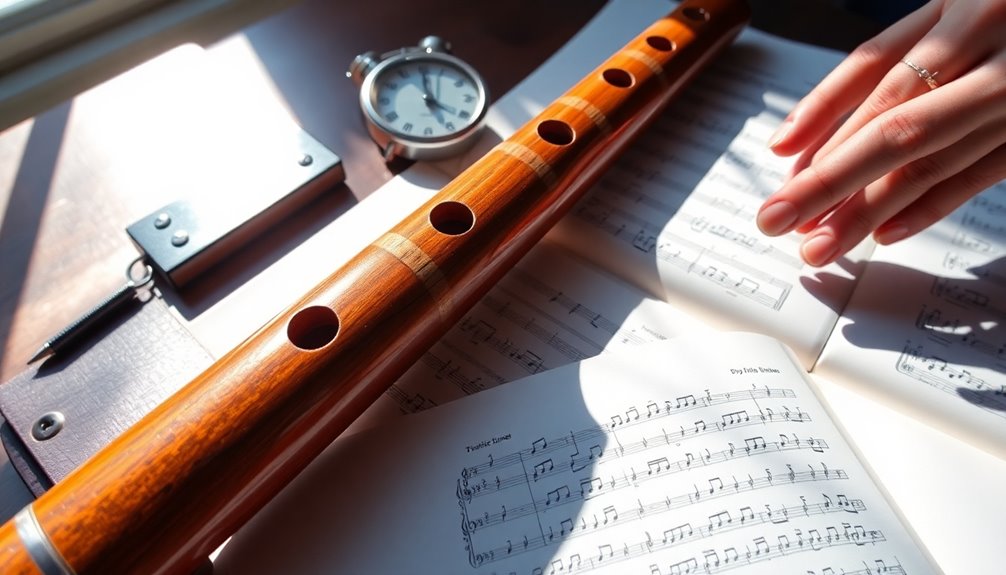To succeed on the flute, create three essential practice routines. First, start with warm-up exercises that enhance your breath control and tone production. Focus on long tones and simple scales to set a solid foundation. Next, develop your technique by incorporating scales, arpeggios, and chromatic runs to improve dexterity and speed. Finally, practice your repertoire by breaking pieces into manageable sections, tackling tough passages with a metronome. By consistently following these routines, you'll see steady improvement and greater musicality. Stick around to uncover additional tips that can elevate your flute playing even further!
Key Takeaways
- Start each session with warm-up exercises to enhance breath control and tone production for a solid practice foundation.
- Incorporate technique drills like scales, arpeggios, and chromatic runs to build finger agility and precision.
- Focus on repertoire by breaking pieces into manageable sections and using a metronome for challenging passages.
- Dedicate specific time blocks for warm-ups, technique, and repertoire to ensure a well-rounded practice routine.
- Regularly reflect on practice outcomes and adjust your routine based on progress and personal goals for continuous improvement.
Warm-Up Exercises

Warm-up exercises are essential for every flutist's practice routine, setting the foundation for a productive session. By incorporating these exercises into your daily practice, you'll enhance your breath control and improve your tone production.
When you start your routine with focused warm-ups, you not only prepare your body but also create a mindset conducive to growth.
Begin with long tones. Choose a comfortable pitch and sustain it, focusing on maintaining a steady breath. This exercise helps you develop breath control, allowing you to manage your airflow and support your sound effectively.
As you hold the note, listen closely to your tone. Is it clear and resonant? If not, adjust your embouchure and breath support until you achieve your desired sound.
Next, try some simple scales. Playing scales at various dynamics and articulations can greatly improve your tone production. Start slowly, ensuring that each note is even and well-supported.
Gradually increase your speed, but always prioritize quality over quantity.
Don't forget to incorporate flexibility exercises, like slurs. This will help you shift smoothly between pitches, enhancing your overall musicality. Additionally, taking care of your flute through proper maintenance ensures that your instrument remains in peak condition, contributing to better sound quality during your practice sessions.
Technique Development

Technique development is essential for elevating your flute playing to new heights. By focusing on finger agility and tone production, you'll find that your overall musicianship improves greatly. Consistent practice routines dedicated to these aspects will help you become a more proficient player. Here's a structured approach to developing your technique:
| Focus Area | Suggested Exercises |
|---|---|
| Finger Agility | Scales and Arpeggios |
| Chromatic Runs | |
| Tone Production | Long Tones |
| Harmonics |
Incorporating a variety of exercises into your practice will keep you engaged and motivated. Start with finger agility exercises like scales and arpeggios, as they help strengthen your fingers and improve your dexterity. Challenge yourself with chromatic runs to build speed and precision.
Next, concentrate on tone production. Long tones are a fantastic way to develop a rich and full sound. Spend time on different dynamics, experimenting with soft and loud playing to enhance your control. Harmonics can also be a valuable tool, helping you understand the instrument's resonance and improve your overall sound quality. Additionally, consistent practice of long tone practice will help you achieve greater stability and clarity in your sound.
Repertoire Practice

Repertoire practice is an essential component of your flute journey, allowing you to apply the techniques you've developed in a musical context. It's not just about playing notes; it's about expressing yourself and connecting with the music.
Start by focusing on your repertoire selection. Choose pieces that challenge you, but also those that resonate with your musical tastes. This balance will keep you motivated and engaged.
As you engage with each piece, break it down into manageable sections. Work on difficult passages slowly, gradually increasing the tempo as you gain confidence. Use your technique exercises to tackle specific challenges within the repertoire. For instance, if a passage requires rapid finger work, practice that section with metronome assistance to build precision and speed.
Performance preparation is key to mastering your repertoire. Once you feel comfortable with the notes, shift your focus to musicality. Consider dynamics, phrasing, and expression.
How do you want to convey the emotions of the piece? Regularly perform for friends, family, or even in front of a mirror. This will help you become comfortable with sharing your music and receiving feedback. Additionally, incorporating pieces from a diverse range of repertoire can enhance your artistic expression and technical abilities.
Frequently Asked Questions
How Long Should I Practice Each Day for Improvement?
To improve, aim for at least 30 minutes to an hour of daily practice.
It's all about practice consistency—short, focused sessions are more effective than infrequent, long ones.
You'll find that regular practice not only enhances your skills but also builds your confidence.
Remember, it's not just about the time you spend; it's about making that time count.
Stay committed, and you'll notice significant progress in your playing!
What Should I Do if I Feel Frustrated While Practicing?
If you're feeling frustrated while practicing, try incorporating mindfulness techniques to center yourself.
Take a few deep breaths, focus on the moment, and let go of negative thoughts.
Positive reinforcement can also help; reward yourself for small achievements, no matter how minor they seem.
Remember, it's okay to struggle—everyone does.
Embrace the journey, stay patient with yourself, and you'll find progress comes with time and persistence.
You're not alone in this!
How Can I Track My Progress Effectively?
Imagine staring at your music sheets, unsure if you're improving.
To track your progress effectively, start a progress journal. Each time you practice, jot down your goals and what you achieved. This isn't just about notes; it's about celebrating small victories.
As you set specific goals, you'll see how far you've come and feel a sense of belonging in your musical journey. It's all about the steps you take together!
Should I Practice With a Metronome?
Yes, you should practice with a metronome!
Using a metronome helps you develop rhythmic accuracy and keeps your playing consistent. It's a great tool for tracking your tempo and ensuring your timing is spot on.
Start slow, then gradually increase the speed as you gain confidence.
You'll feel a sense of belonging within the music community as you master your timing, and your skills will improve considerably.
Keep at it!
How Do I Maintain My Flute in Good Condition?
Maintaining your flute is like nurturing a delicate flower; it thrives with care.
Start with regular flute cleaning using a soft cloth to wipe down the exterior after each play.
Don't forget to swab the inside to remove moisture.
Check for loose screws and pads, and consider a yearly check-up with a professional.
With these maintenance tips, you'll keep your flute in top shape, ensuring it sings beautifully every time you play.
Conclusion
Incorporating these three essential flute practice routines into your daily regimen can transform your playing. For instance, imagine a student named Emily who struggled with tone quality. By dedicating time to warm-ups, focusing on technique, and consistently working on her repertoire, she saw remarkable improvement in just a few months. Stick to these routines, stay patient, and you'll not only enhance your skills but also find joy in your musical journey. Start today, and watch your progress unfold!






